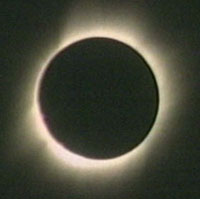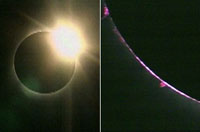21st Century longest solar eclipse
22 July 2009

- © NASA TV
- The sun's corona, or outer atmosphere, is visible during totality -- when the sun is totally obscured by the moon's shadow
With the maximum duration of 6 min 39 s, it is the longest solar eclipse in the 21st century.
22 July will feature the longest solar eclipse of the 21st Century. At 6 minutes and 39 seconds, it will be an impressive sight for those able to see it. Visible from mainland Asia, Japan's Ryukyu Islands, and through the Pacific Ocean, the experience for people in those regions will be incredible.
The path of the Moon's umbral shadow begins in India and crosses through Nepal, Bangladesh, Bhutan, Myanmar and China. After leaving mainland Asia, the path crosses Japan's Ryukyu Islands and curves southeast through the Pacific Ocean where the maximum duration of totality reaches 6 min 39 s. A partial eclipse is seen within the much broader path of the Moon's penumbral shadow, which includes most of eastern Asia, Indonesia, and the Pacific Ocean.

What is a Solar Eclipse?
A solar eclipse occurs when the moon passes in a direct line between the Earth and the sun. The moon's shadow travels over the Earth's surface and blocks out the sun's light as seen from Earth.
When a total eclipse does occur, the Moon's shadow covers only a small portion of the Earth, where the eclipse is visible. As the Moon moves in its orbit, the position of the shadow changes, so total solar eclipses usually only last a minute or two in a given location.
In ancient times, people were frightened by solar eclipses (even back then people realized that the Sun was essential to life on Earth). Now eclipses are of great interest to the public and to astronomers. Eclipses provide an opportunity to view the Sun's outer atmosphere, the solar corona.
Related links:
:: NASA (website)
:: Photo Gallery
- Source:UNESCO SC
- 22-07-2009
- © NASA TV - Left: The sun creates a "diamond ring" effect as it emerges after totality. Right: Prominences which are dense clouds of material suspended above the surface of the Sun by loops of magnetic field are visible at the edge of the moon's shadow

